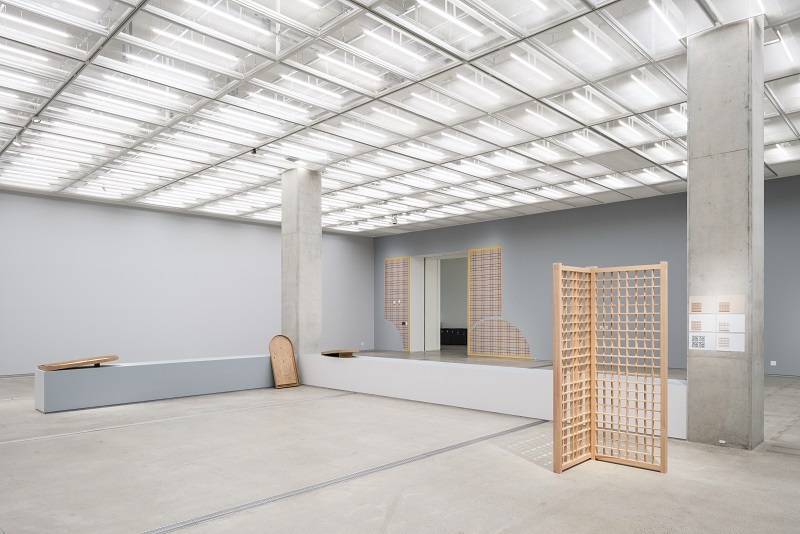[Herald Interview] Installation artist Lee Seul-gi gets playful with metaphors
By Park YunaPublished : March 29, 2021 - 18:43

Korean-born and Paris-based installation artist Lee Seul-gi enjoys using metaphors. She explores metaphors in ordinary objects and different languages through installation works and folkcraft often in collaboration with community artisans. Some of her well-known artworks are her Korean “nubi,” or quilt blanket series, that show diagrammatic designs that are whimsically translated into Korean proverbs.
Lee, who recently won the Korea Artist Prize 2020, is currently showing “Dong Dong Dari Gori” at the National Museum of Modern and Contemporary Art, Korea, as part of an exhibition showcasing works by Lee and three other artists who were shortlisted for the prize.

Lee’s work was inspired by Korean architectural elements found in traditional doors and windows. The wooden lattices of traditional windows and doors, called “munsal,” is painted like murals at the four entrances to the exhibition hall -- the Northeast Gate, Northwest Gate, Southwest Gate and Southeast Gate. Painted with the assistance of “dancheong” artisans -- experts in traditional decorative painting of wooden structures -- the munsal paintings look like different phases of the moon.
“I thought of sexually suggestive folk songs sung by women. That was the start of my project. Then I thought of the moon and moonlight and put different shapes of the moon to the gates of the exhibition halls,” Lee said during a phone interview from Italy with The Korea Herald.

The work is a play on words of the Korean word “mun.” While munsal means a “door or window frame,” “mun” also sounds the same as the English word, “moon.” A relationship between moon and doors already exist in the sentiments of Koreans, the artist said.
The artist often comes up with titles for her works that sound like incantations. Take “Dong Dong Dari Gori,” for example. “Dongdong,” also called “dongdong dari,” was a love song sung by women from the Goryeo Kingdom (918-1392). The song takes the form of “dalgori,” also known as “wollyeongche,” or song of the 12 lunar shapes.
“Actual 4-meter-tall munsal were planned to be installed at the gates, but there were structural issues and the museum’s guideline regarding entrance doors, so we unfortunately had to give up on the plan,” Lee said. Instead the artist invited dancheong artisans to collaborate with her on the project and presented a sample of the installation work that she created with munsal artisans.

"The design of munsal may look simple. But if you examine the design closely, you may find its own rhythm derived from the weaving pattern,” Lee said.
At the center of the exhibition hall are unusual wooden board devices -- entitled BAGATELLE1, BAGATELLE2 and BAGATELLE3 -- inspired by the French game, Bagatelle. Bagatelle is a traditional game played in 17th century France, which then has evolved into billiard, pachinko and pinball games. Using a stick, the player puts balls into holes that are guarded by wooden pegs.
“Folklore is universal. I want the exhibition place to become a place for people to understand better and empathize with one another. I am really interested in anthropological factors, particularly like the maternal society (matriarchy),” Lee said. “To me, Bagatelle seemed to represent a woman’s body and the game reminded me of sexual act.”

Small glass containers that she designed with craft artists are hung on the wall, holding water from rivers around the world sent by Lee’s friends. The glass containers resemble the rivers where the water came from.
“I am thinking about communities and how we can live better in communities. The good thing about the pandemic is all countries are going through the same experience and trying to come up with solutions altogether, including (solutions for) environmental issues,” Lee said.
The exhibition of the Korea Artist Prize 2020 at MMCA Seoul runs until April 4.
By Park Yuna (yunapark@heraldcorp.com)











![[Today’s K-pop] BTS pop-up event to come to Seoul](http://res.heraldm.com/phpwas/restmb_idxmake.php?idx=644&simg=/content/image/2024/04/17/20240417050734_0.jpg&u=)





![[KH Explains] Hyundai's full hybrid edge to pay off amid slow transition to pure EVs](http://res.heraldm.com/phpwas/restmb_idxmake.php?idx=652&simg=/content/image/2024/04/18/20240418050645_0.jpg&u=20240418181020)

![[Today’s K-pop] Zico drops snippet of collaboration with Jennie](http://res.heraldm.com/phpwas/restmb_idxmake.php?idx=642&simg=/content/image/2024/04/18/20240418050702_0.jpg&u=)